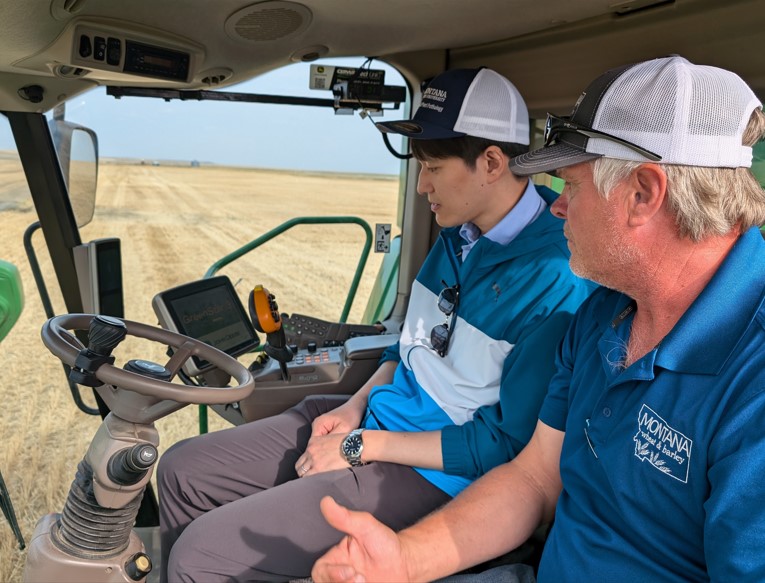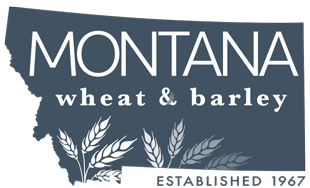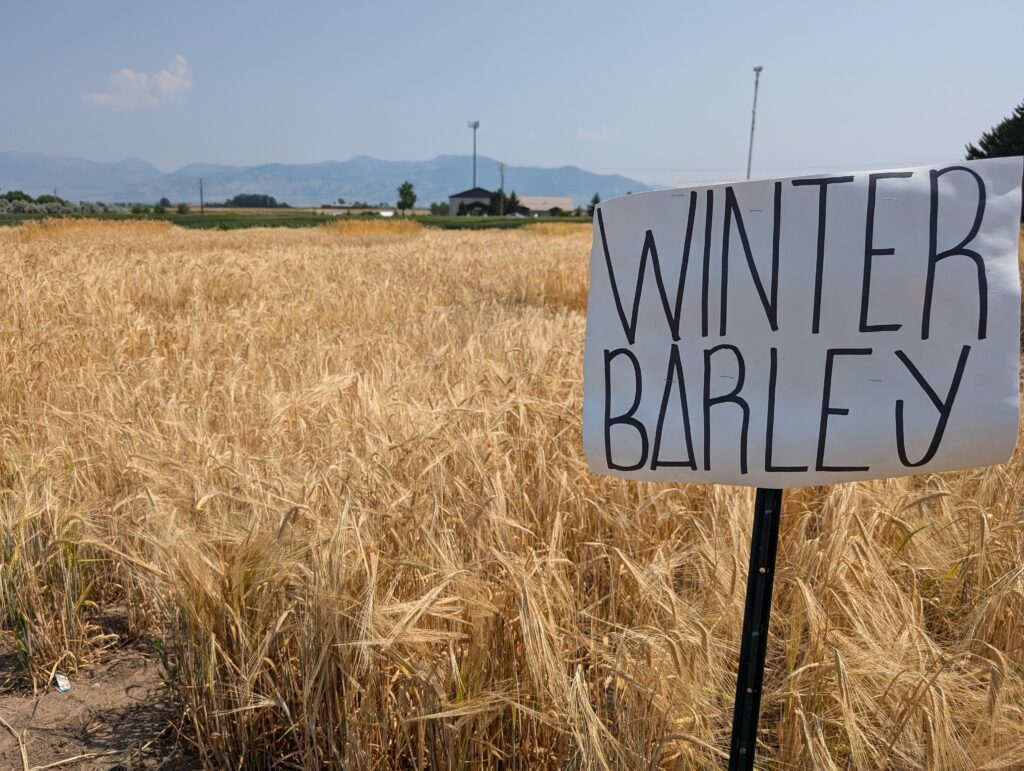By Lee Dahlman, District 4 Director, Montana Wheat & Barley Committee (MWBC) and Lori Wickett, MWBC Research & Communications Director
Written for Prairie Grains April ’25 Issue — What does the horizon hold for barley growers? That question’s answer looks as muddy as Montana spring corrals – if we get some much-needed rain. For Montana growers, barley has been an oft-chosen production crop since the first shovel turned over clay loam. Our average annual moisture be just six to nine inches in prairie counties and yet Montana remains number one for planted barley acres in the US. Quality barley loves the 406 area code. Thanks to great barley variety improvement, the last 25 years have proven that dryland malt barley can and will prove profitable for growers when rainfall is timely. That is, until beer drinkers began to choose differently a few years ago, depressing the beer market.

Lee Dahlman discusses combine operations with an Asian customer last fall.
Over the past several months, MWBC has been knee-deep in conversations with fellow barley growers nationally, including conferences for the National Barley Improvement Committee (NBIC), the National Barley Growers Association (NBGA) and the US Grains Council. Our focus has largely fallen on two areas of concern: first, how to compensate for declining domestic beer consumption, and second, how to diversify barley for other market uses. One thing is certain: barley is no longer a commodity, but has evolved into a specialty crop.
Adult Beverage Consumption – Most of the Eggs in This Basket
In 2022, the US barley crop totaled $1.07 billion in crop value with 68 percent going to beer and 22 percent to feed. A July, 2024 article in Beverage Industry does a good job of summarizing trends in the adult beverage market, which growers should follow if they are going to continue to grow barley for the brewing industry. Consumers today are increasingly driven by tasty profiles of flavored teas, cocktail-styles and hard sodas, all gaining traction in double digits.
Another increase in adult beverage sales is found in spirits (six percent growth in 2023 with moderate slowing in 2024). Some experts attribute this to a combination of health-conscious buying combined with high inflation. The greatest contributing factor to spirits growth, however surprising it might be, is ready-to-go cocktails or “cocktail in a can.”

Visiting Sveum Bros. farm with Constellation Brands, summer, 2024.
On the surface, choosing a more flavorful beer seems to run parallel to the popularity of imported beer brands. Modelo Especial earned $4.18 billion in revenues in 2023, up 16.2 percent over 2022. While Twisted Tea’s 2023 sales were an impressive $1.3 billion, their increase was an astonishing 26.8 percent over the previous year, testimony of consumers’ move toward more flavorful product lines.
The competition thickens with legal cannibas-infused drinks as an alternative to alcohol, followed by the ironic twist in perceptions “discovered” by many younger buyers that beer contains carcinogens (a fact of all alcohol, classified as carcinogenic to humans in 1987 by the National Cancer Institute).
It is difficult to know how long before our good beer aficionados might be replaced by new generations desiring a Cayman Jack Margarita. If Gen Z is any indication, the growth in import brands such as Modelo may not prove strong enough to outweigh the demand for these fun and flavorful tastes. To be competitive, barley will need to find new opportunities.
Exploring New End-uses for U.S. Barley
Dryland malt barley varieties are a good example of barley’s development. We should use that history lesson for further research into different barley end-uses. Montana’s new interest in building livestock feedlots and processing facilities has refreshed conversations about feed barley improvements as an alternative to corn. Like Canada, we have a harder time growing dryland corn versus barley due to our climate and other environmental factors.
Currently, feed processing that breaks open barley’s outer hull (making it more digestible for cattle) without over-processing is a tricky business. Visits with MSU’s barley breeding program have brought hope. If we could develop a readily digestible feed barley (making it easier for cattle to break down barley’s starch and protein), while outshining corn in nutrition, we could meet two important demands for Montana’s agriculture industry.
At MWBC, we are also curious about barley research into health and nutritional benefits for human consumption. For more than 50 years, we’ve invested heavily in the agronomy side with goals such as drought tolerance, yield, disease resistance or protein levels, all with great results! The time might not get any better to expand research into how barley might improve human health, such as its contribution of beta-glucan to help control diabetes, obesity or high cholesterol. And with consumers demanding healthy choices, non-alcoholic beer has gained popularity, leaping 30 percent in 2023 sales and another 25 percent in 2024.

MWBC board members Keven Bradley (Cut Bank), Lee Dahlman (Dutton) and Cindy McKamey (Great Falls) share a moment of “intense planning” prior to Malteurop’s annual Barley Days factory tour.
With Montana barley’s longtime brewer relationships, it has been a tough reality check as the availability of grower contracts has dramatically changed in recent years. Fear comes with those shifts. A similar situation arrived for our colleagues in corn and soybeans. Quality research at major land grant institutions and private industry led to discoveries for these growers resulting in value-added revenue streams such as ethanol and industrial applications. At MWBC, we believe that barley may have been overlooked for such strategies.
For now, improving existing conditions are paramount. Barley leaders and industry stakeholders have worked on the FY26 appropriation priorities while helping shape the Emergency Commodity Assistance Program (ECAP). These are temporary measures, however. If barley is to remain a viable crop for farmers, we’ll need to find additional baskets for a more balanced market distribution, while marketing it like the specialty crop it has become.
##
Lee Dahlman, of Dutton, MT farms in what is known as the “Golden Triangle,” some of the most productive farm ground in Big Sky Country. He is a fourth generation farmer producing barley, hay, lentils and peas. He also raises cattle while serving on the Tri-County Water District and the Teton County Conservation District.

